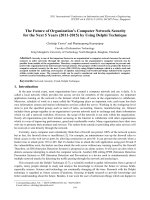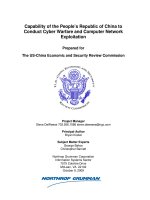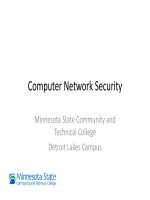computer network english lecture
Bạn đang xem bản rút gọn của tài liệu. Xem và tải ngay bản đầy đủ của tài liệu tại đây (487.54 KB, 49 trang )
Computer
Networks
2
Networking
Computer network
A collection of computing devices connected in
order to communicate and share resources
Connections between computing devices can be
physical using wires or cables or wireless using
radio waves or infrared signals
3
Overview
•
Network Topology
how is hardware (physically) connected?
•
Addressing
how is a message’s destinations identified?
•
Message Delivery
should all data be sent in the same fashion?
•
Routing
what path through the network is taken?
•
Security
how can strangers pass (private) messages?
4
Networking key terms
Node (host)
Any device on a network
Data transfer rate (bandwidth)
The speed with which data is moved from one
place to another on a network
5
Networking
Computer networks have opened up an entire
frontier in the world of computing called the
client/server model
Figure 15.1 Client/Server interaction
6
Networking
Protocol
A set of rules that defines how data is formatted and
processed on a network; i.e., rules that allow client/server
interaction
File server
A computer that stores and manages files for multiple
users on a network
Web server
A computer dedicated to responding to requests (from the
browser client) for web pages
7
Issue 1: Topology
•
If every pair of computers on a network had a
dedicated communication link, passing messages
would be direct and straightforward. (e.g., the
“hotline” between the White House and Kremlin)
•
Unfortunately, with hundreds, thousands or
millions of computers on a network, they cannot all
have direct links to each other.
8
Network topology
Local-area network (LAN)
A network that connects a relatively small number of
machines in a relatively close geographical area
Ring topology connects all nodes in a closed loop on which
messages travel in one direction
Star topology centers around one node to which all others
are connected and through which all messages are sent
Bus topology nodes are connected to a single
communication line that carries messages in both directions
Types of Networks
Ethernet
The industry standard bus technology for
local-area networks
Figure 15.2 Various network topologies
10
Pros and Cons
Pro’s and Con’s
–
Number of links (they cost money)
–
Network Performance
How efficient is communication?
–
Network Reliability
How does network respond to overload?
How susceptible is network to collapse?
Best choice depends on the size of the network
11
Types of Networks
Wide-area network (WAN)
A network that connects local-area networks over a
potentially large geographic distance
Metropolitan-area network (MAN)
The communication infrastructures that have been
developed in and around large cities
Gateway
One particular set up to handle all communication going
between that LAN and other networks
12
Types of Networks
Figure 15.1 Local-area networks connected across a
distance to create a wide-area network
13
Types of Networks
Internet
A wide area network that spans the planet
So, who owns the Internet?
14
Internet Connections
Internet backbone
A set of high-speed networks that carry Internet
traffic, provided by companies such as AT&T,
Verizon, GTE, British Telecom, and IBM
Internet service provider (ISP)
A company that provides other companies or
individuals with access to the Internet
15
Internet Connections
Various technologies available to connect a home computer
to the Internet
Phone modem converts computer data into an analog
audio signal for transfer over a telephone line, and then a
modem at the destination converts it back again into data
Digital subscriber line (DSL) uses regular copper phone
lines to transfer digital data to and from the phone
company’s central office
Cable modem uses the same line that your cable TV
signals come in on to transfer the data back and forth
16
Internet Connections
Broadband
A connection in which transfer speeds are faster
than 768 kilobits per second
–
DSL connections and cable modems are
broadband connections
–
The speed for downloads (getting data from the
Internet to your home computer) may not be the
same as uploads (sending data from your home
computer to the Internet)
Issue 2: Addressing
If a device wants to send a
message to another, how does
it specify precisely which
device?
To what address?
18
Network Addresses
Hostname
A name made up of words separated by dots that uniquely
identifies a computer on the Internet:
Example: www.mathcs.slu.edu
IP address
An address made up of four one-byte numeric values
separated by dots that uniquely identifies a computer on
the Internet
Example: 192.0.0.1
Note: No direct way to translate between these!
19
IP Addresses
•
An IP address can be split into
–
network address, which specifies a specific
network
–
host number, which specifies a particular machine
in that network
Figure 15.9
An IP address
is stored in
four bytes
Where does the host number
come from?
20
Network Classes
•
The first part of the IP address designates the
network. The number of bits in the network
address depends upon the size of the network
•
Class A network: Designated by first byte
(very large; e.g., Apple has 17.x.x.x, MIT has 9.x.x.x)
•
Class B network: Designated by first two bytes
(moderate size; e.g., SLU has 165.134.x.x)
•
Class C network: Designated by first three bytes
(very small; e.g., Iowa Public Television iptv.org has 205.221.205.x)
21
IPv4 and IPv6
•
IPv4 is the protocol using 32-bit addresses. It has
been officially used since 1977
•
IPv6 is a new protocol (defined in 1996) using
128-bit addresses. The Internet is in the process
of transitioning to IPv6
With a vastly larger address space, it provides
better separation of network location and host
identity, allowing better portability when devices
move from network to network.
22
Domain Name System
•
A hostname generally consists of the computer
name followed by the domain name
•
csc.villanova.edu is the domain name
–
A domain name is separated into two or more
sections that specify the organization, and
possibly a subset of an organization, of which the
computer is a part
–
Two organizations can have a computer named
the same thing because the domain name makes
it clear which one is being referred to
23
Domain Name System
matisse.csc.villanova.edu
Computer
name
Domain name
TLD
24
Domain Name System
Figure 15.10 Top-level domains, including some relatively new
ones
25
Domain Name System
Organizations based in countries other than the United
States use a top-level domain that corresponds to their
two-letter country codes
Figure 15.11
Some of the top-level domain
names based on country codes









